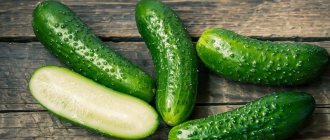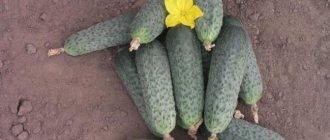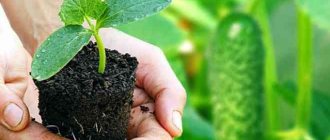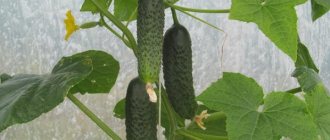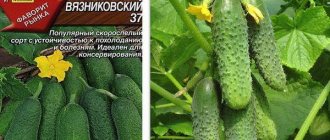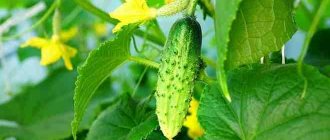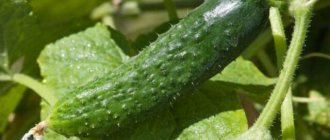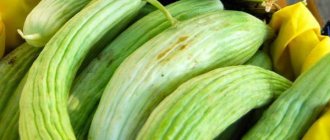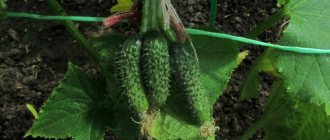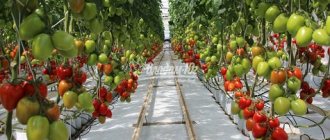The Ecole F1 cucumber has many of the same advantages as the new generation of hybrids. He doesn’t need bees for the fruit to set, for the cucumbers to be straight, beautiful and tasty, and for a rich harvest. In addition, the hybrid tolerates unfavorable conditions well and resists diseases.
| Landing location | Ripening time | Mode of application | Fruit length | Group | Fruit smoothness | Pollination method |
| Universal | Early ripening (35-45 days) | Universal | Short (gherkins) - less than 10 cm | Hybrid | Highly lumpy | Parthenocarpic |
Description and characteristics of the variety
The cucumber hybrid Ecole F1 was created by Dutch specialists at Syngenta Seeds. In Russia, seeds are distributed by agro. In 2007, the cucumber was included in the Russian State Register. Requirements for breeding conditions vary depending on the region. In the North Caucasus, it is better to cultivate the vegetable in open ground, and in the Lower Volga, Northwestern, Central Black Earth, Eastern and Western Siberia, and the Urals, it grows well in greenhouses, but is also capable of bearing fruit in open ground.
The hybrid is drought-resistant. During dry periods it does not lose its ovary. On the contrary, its frost resistance is not increased.
The cucumber has medium or long vines that grow up to 2-3 meters. Bouquets of 4-5 ovaries are formed in the nodes. Bees are not needed for their appearance, since the cucumber is parthenocarpic. Ripening occurs on the 40-45th day after seed germination.
Zelentsy are small, 6-9 cm each. You can collect gherkins (about 5 cm each) and pickles (from 3 to 5 cm). The weight of mature greens is 62-72 g. The dark green skin shows faint stripes and spots, as well as large tubercles. The spines are white.
The pulp is tender, juicy and crispy. The fruits are suitable for harvesting, including canning gherkins and pickles, as well as for fresh consumption.
Cultivation care
Cucumber Ecole f1 () refers to hybrids with medium branching of lateral shoots. It is necessary to regulate their occurrence, since the plant, distracted by the formation of green mass, significantly reduces fruiting. After the formation of 6-7 leaves, the central stem of the hybrid is pinched, stimulating branching and increasing productivity. For fruiting, 1-2 strong stems are left, the remaining side shoots growing from the axils of the leaves are cut off, leaving small stumps. Do not forget about timely harvesting of fruits.
Cucumber beds must be kept clean and tidy
Shallow, careful loosening and regular weeding are necessary. There are rules for watering cucumbers:
- use only warm water, applying it to the root;
- You cannot water the plant with a hose, dousing it entirely.
Advantages and disadvantages
Pros:
- wonderful taste and delicate consistency of the pulp;
- high productivity;
- early maturation;
- fruit formation without pollination;
- resistance to heat and drought;
- long-term fruiting (the harvest can be obtained from June to the last days of September);
- immunity to cucumber mosaic, olive spot and powdery mildew.
Minuses:
- the fruits are not suitable for harvesting seeds;
- If harvested at the wrong time, the greens overgrow and become barrel-shaped.
When can you plant a variety?
Approximately, planting cucumbers without seedlings is carried out at the end of May, when the air temperature during the day reaches 22°C and at night does not fall below 15°C. You can also focus on the soil temperature: if at a depth of 10 cm the temperature is 15°C, you can sow.
Important! If you plant cucumbers too early, there is a possibility of freezing or poor, painful development of bushes with poor fruiting. Sowing seeds for seedlings is carried out in early April, so that before planting in open ground the plants have already grown a little and built up a strong root system.
Seeds are sown for seedlings in early April, so that before planting in open ground the plants have already grown a little and developed a strong root system.
Landing
Loamy and sandy loam soil, loose, rich in humus and with neutral acidity (pH 6-7), is suitable for growing cucumbers. The ground should not become swampy, and water should not accumulate in the lowlands. Sunny or slightly shaded areas are suitable.
The optimal predecessors are:
- potatoes and other root vegetables;
- tomatoes;
- pepper;
- eggplant;
- onion;
- cauliflower;
- corn;
- beans and other legumes.
It is not recommended to plant after pumpkin and melon crops, since they have common diseases with cucumbers.
Seeds are sown in open or greenhouse soil when its temperature is +15. For seedlings - 20-30 days before transplanting. To get healthy seedlings, you need:
- Use peat pots with a diameter of 10-12 cm.
- Make a soil mixture of 2 parts humus, 1 or 2 parts peat and 1 part each of turf soil and sawdust, and then add a little wood ash and nitrophoska.
- Provide the seeds with a temperature of at least +25 before germination.
- After emergence of seedlings, maintain a temperature regime of +18-20.
- Keep the bushes on a sunny windowsill or under special lamps.
Cucumbers cannot tolerate cold temperatures below +5-8 degrees. The optimal temperature for adult seedlings and plants is +22.
In open ground, holes are made at intervals of 10 cm from each other. Moisten generously and place several seeds in each. Subsequently, when the shoots appear, they are thinned out, leaving the strongest bushes. When true leaves appear, thin out again so that the plants are spaced 30cm apart. The excess ones can be carefully dug up and transplanted to another place.
From the cold, cover the seedlings with film at night.
Cultivation care
Cucumber Ekol f1 (producer Semko) is a hybrid with medium branching of lateral shoots. It is necessary to regulate their occurrence, since the plant, distracted by the formation of green mass, significantly reduces fruiting. After the formation of 6-7 leaves, the central stem of the hybrid is pinched, stimulating branching and increasing productivity. For fruiting, 1-2 strong stems are left, the remaining side shoots growing from the axils of the leaves are cut off, leaving small stumps. Do not forget about timely harvesting of fruits.
Cucumber beds must be kept clean and tidy
Shallow, careful loosening and regular weeding are necessary. There are rules for watering cucumbers:
- use only warm water, applying it to the root;
- You cannot water the plant with a hose, dousing it entirely.
Growing and care
As they grow, the lashes are tied to supports and shaped. All lateral shoots and ovaries are cut off up to the 3rd bottom leaf, the remaining ones are pinched after several leaves.
Water every 3-5 days with warm water after sunset or in the morning. In hot weather and during the fruiting period, you can water every day, adding up to 30 liters of water per 1 square meter. m. But moisture stagnation should not be allowed.
There are three basic fertilizers:
- After 10 days from the moment of transplantation, water the soil with a solution of manure or add 15 g of Diammofosk fertilizer per square meter.
- 2 weeks after the first time, water with a solution of 40 g of nitrophoska per 10 liters of water or re-apply Diammofoska at 20 g per 1 sq. m. m.
- During the fruiting period, use fertilizer with potassium (30 g per bucket of water). If necessary, repeat weekly.
What is remarkable about Ecole F1 cucumbers?
Watering should be done before sunrise or after sunset
Cucumbers need plenty of moisture. The crop's requirement for watering is explained by the close location of the root system to the top layer of soil, which dries out quickly. Lack of moisture will cause a deterioration in the taste of the fruits, as well as their yellowing. There are certain watering norms. But you also need to focus on external factors. For example, in cold rainy weather, watering is reduced, otherwise the roots may rot.
Water the cucumbers from a watering can with a sprayer; the optimal time of day is morning or evening. During the day, in hot sunny weather, the procedure is not performed, as this will lead to the formation of burns on the plant. For cucumbers, use only warm water at a temperature of about 25 °C.
Harvesting and storage rules
You can harvest when the greens have reached a size of 5–10 cm. Pickles of 3 cm in size for pickling are allowed. Harvesting should occur daily in the morning and evening, as greens ripen very quickly. It is better to cut cucumbers with pruning shears or a knife, leaving the stalks on the plant.
Did you know? In the wild, uncultivated forms of cucumbers were first discovered in the Himalayas; this place is considered the birthplace of the plant. Fruiting thickets at the foot of the mountains are still found.
Since cucumbers can prick your hands during the picking process, it is best to protect your skin with gloves. The first harvest can be obtained already in mid-June; fruiting of the variety continues until the beginning of September. The harvested crop must be stored in a cool place, preferably in the refrigerator or cellar. The shelf life is 10–15 days.
Thus, Ecole cucumbers can be grown on your own plot without much difficulty and get a large, high-quality harvest. To make the growing process as clear and simple as possible, it is recommended to follow the tips that are described in detail in the article.
Review of variety qualities
The description of the variety says that it is an early-ripening gherkin-type hybrid, parthenocarpic, short-fruited with a short growing season. This hybrid, the result of the work of Dutch breeders, is quite unpretentious and tolerates a wide variety of climatic conditions.
It can be cultivated both in an open area and in a greenhouse in two ways - seed and using seedlings. The latter is most preferable, since ready-made hardened seedlings have a better chance of growing and bearing fruit in due time.
And the latter, it must be said, are extremely tasty, they have dense, juicy pulp without bitterness or voids inside. The rich dark green color and pronounced “tubercle” of the fruit are the hallmark of this variety, as can be seen in the photo.
If all agrotechnical conditions are met, the yield can reach 18–20 kg per 1 m². This is largely achieved thanks to short internodes and a long fruiting period. Other advantages of the Ecole f1 cucumber variety include:
- Resistance to major fungal diseases - powdery mildew, brown spot, viral mosaic, rot.
- Formation of ovaries throughout the season.
- Among the main characteristics of the variety are high commercial qualities due to the classic ratio of fruit length and width - 3/1.
- Stable and high yield.
- Self-pollinating.
- Good keeping quality. This hybrid also tolerates transportation well.
Reviews
“Ekol F1 cucumbers are an excellent variety for preservation; there are no words to describe these cucumbers. The family loves them very much. I prepared a snack for the whole winter for both myself and the children. I collected them every day when they were very small, no more than 5 cm. But it’s difficult to do this without gloves - they are painfully prickly. I am very pleased with the yield; there were a lot of ovaries. The more you shoot, the faster new ones grow. We had fresh cucumbers until the fall.” Lyudmila, 47 years old, Shebekino, Belgorod region.
“I couldn’t go to the dacha every day - I was busy at work. The heat was over 30 throughout August. I watered it once a week, as long as I could manage. Not everyone survived. I was surprised by the bed of “Ekol F1” cucumbers. No one expected such resistance to weather conditions from a new variety for us. I bought the seeds because I was led by reviews - I chose them from the catalog and photos. They outgrow quickly and become tasteless. If you pick it in time, it’s a wonderful variety for our area.” Alexander, Kamyshin, Volgograd region.
Description of fruits
The Ecole variety cucumber produces cylindrical fruits. Their length varies from 5 to 10 cm, the average weight is 90-95 g. Reviews note that the surface of Ecole cucumbers is lumpy, and the skin is covered with many small white spines, as can be seen in the photo, for example.
The peel of the fruit is dark green. The pulp of cucumbers is tender and crispy. There are no voids and no bitterness in it. The taste of the fruit is described as moderately sweet, the fruit is not bitter.
The scope of application of Ecole cucumbers is universal. They are mainly grown for fresh consumption, however, they are also widely used for pickling and preservation. The small fruits and dense structure of the pulp earned many positive reviews from those summer residents who used cucumbers for pickling.
Planting seedlings
Gardeners note that when planting, it is necessary to deepen the stems of cucumbers in order to increase their root system. This is justified exclusively in the southern regions of the country. Since the growth of a large number of roots stops the growth of the above-ground part, in temperate latitudes with short and cool summers, the cucumber does not have time to produce a full harvest. Therefore, when planting seedlings in a garden bed or greenhouse, you should bury the seedling at the level at which it was in the pot.
Cucumber seedlings should be prepared for planting. A week before planting, they begin to harden it - take it out into the open air, controlling the temperature.
Characteristics of Ecole cucumbers
In the State Register of the Russian Federation, cucumbers of the Ekol variety are indicated as a form suitable for growing in open ground and greenhouses. The key characteristic of the variety is resistance to many diseases. In particular, plantings rarely suffer from powdery mildew, brown spot (cladosporiosis) and cucumber mosaic virus.
The frost resistance of the Ekol variety is average. During periods of prolonged drought, fruits do not fall from the shoots, as happens in most other species. The bushes bear fruit well both in the sun and in the shade.
Productivity
Fruiting of cucumbers of the Ecole F1 variety occurs on average 40-45 days after the appearance of the first shoots. The peculiarity of fruit set is that the bushes do not need pollination - the hybrid is classified as a parthenocarpic type of cucumber.
The yield of the variety is 7-9 kg of fruits per bush. Fruiting can be stimulated by timely blinding of the lower nodes on the shoots. To do this, the axillary ovaries are removed, which promotes the development of the plant’s root system and an increase in the total number of fruits.
Resistance to pests and diseases
According to reviews from gardeners, cucumbers of the Ecole F1 variety have excellent immunity. They are resistant to many diseases that are typical for cucumbers, however, there are a number of diseases that may pose some danger to plantings, namely:
- downy mildew;
- tobacco mosaic virus;
- white rot.
The main cause of infection is stagnation of water as a result of excessive watering and ignoring the rules of crop rotation. Prevention of these diseases comes down to spraying the beds in advance with a solution of Bordeaux mixture and copper sulfate. Treatment of plants with mullein solution also shows good results. To prevent the disease from spreading to neighboring bushes, the affected areas of cucumbers are removed.
Insects infect cucumbers of the Ecole F1 variety infrequently, however, this does not mean that preventive measures can be neglected. The following pests pose the greatest threat to the hybrid:
- whitefly;
- melon aphid;
- spider mite
Plants are sprayed against whiteflies with a soap solution. As a preventive measure against the invasion of this pest, it is recommended to fertilize cucumbers with manure. Sticky traps have also proven themselves to be effective in the fight against whiteflies.
Spraying with pepper infusion helps against spider mites. Melon aphids are repelled by the Karbofos solution.
Pros and cons of the variety
The positive characteristics of Ecole cucumbers include the following qualities:
- consistently high yields;
- resistance to many diseases;
- attractive appearance of the fruit;
- drought resistance - fruits do not fall for a long time even with a lack of moisture;
- shade tolerance;
- the possibility of harvesting part of the harvest in the form of pickles;
- possibility of long-term storage without loss of presentation and quality of fruits;
- good taste - cucumbers do not taste bitter.
The disadvantages include, first of all, the fact that planting material for cucumbers of the Ecole F1 variety cannot be prepared independently. The fact is that this is a hybrid form, which means you will have to buy seeds in the store every year.
Also in the reviews, the disadvantages include the thorniness of the fruit, which makes harvesting difficult, and vulnerability to downy mildew. In addition, if the harvest is not harvested on time, the cucumbers begin to barrel.
Diseases and pests
Breeders worked hard to ensure that this variety of cucumbers was not particularly sick. But due to prolonged bad weather and cold weather, plants can still become ill.
Table: Ecole F1 diseases, treatment methods
| Disease | Symptoms | Treatment options |
| Powdery mildew | A light coating forms on the leaves and they dry out. | Spray with Triovit, diluted according to the recipe on the package. |
| Gray rot | Loose light coating throughout the plant. | According to the instructions, dilute the fungicide Switch WG 62.5. |
| White rot | There is a loose white coating on the fruits and stems. | Remove diseased plants and fruits, spray with a solution of potassium permanganate, sprinkle with wood ash. |
| Downy mildew | Brown-yellow oily spots on the leaves. | Dilute according to instructions, treat with Topaz and Ridomild Gold. |
| Cucumber mosaic | Change in leaf shape, spots. | Remove diseased plants. |
Photo gallery: cucumber diseases
With gray rot, a gray loose coating is visible on all parts of the plant
White coating on stems and fruits is a sure sign of white rot disease in cucumbers.
With powdery mildew, the leaves become covered with light yellow spots and dry out over time. A gray coating appears at the bottom of the leaf plate
Cucumber mosaic cannot be treated; the affected bushes will have to be destroyed as quickly as possible
When affected by downy mildew, the plant practically loses its leaves.
Table: parasites in cucumber beds
| Pest | Signs | Control measures | Prevention |
| Aphid | Leaves wrinkle and curl. | Treat with Karbofos, Fitoverm (according to instructions). |
|
| Spider mite |
|
| |
| Whitefly | The leaves darken and dry out. | Rinse the leaves with clean water. |
Photo gallery: you need to know pests by sight
Hordes of aphids can suck all the juices out of a plant
Whitefly is one of the main enemies of cucumber plants.
When attacked by spider mites, cucumber leaves dry out
